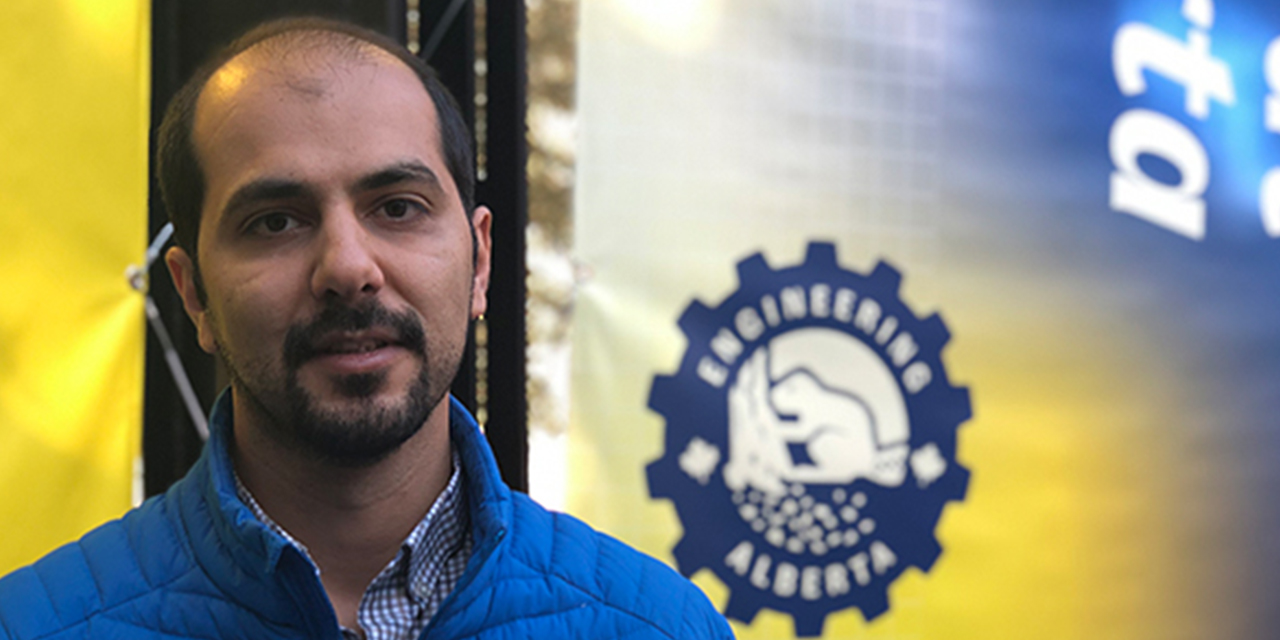
Milad Nazarahari, 2019 Dorothy J. Killam Memorial Graduate Prize winner. (Photo: Kevin Chavez Laxamana)
For many survivors of stroke and other brain and spinal cord injuries, relearning the skills required to walk can involve months of physical therapy. Because therapists are available at most a few hours per week, patients need to do much of that training on their own.
That time away from professionals, notes mechanical engineering PhD candidate Milad Nazarahari, carries risks. Patients walking on their own may learn unhealthy patterns - bending their joints into unusual angles, for instance, or contacting the ground with their feet in problematic ways.
"This can cause [a] loss of balance and increase the risk of falling. And it actually reduces people's functional ability to do different things - to do their job or participate in social activities."
Helping survivors to avoid negative outcomes is a key challenge for therapists. As they seek to diagnose problems and help patients to develop better skills, Nazarahari says, they can benefit from quantitative, real-time data. And that's where his research comes in.
"When patients are in the lab, we can make use of motion-capture systems that analyze the movement of the lower limbs" to provide this data to the therapists, he says. "But we can't use motion-capture outside the lab, and because it's more expensive, it is not available in many hospitals."
So Nazarahari is developing new technology that connects relatively inexpensive portable sensors, known as "wearable sensors," with wireless software that can be loaded onto patients' smart phones and taken home with them.
In combination, the technology provides therapists with a wealth of quantitative data that can help guide their rehabilitation plans - offering a path to better and longer-lasting outcomes for patients.
From screens to goggles
The first step in disseminating the technology, Nazarahari says, involves reaching out to the medical community. "We want to make our technology available to therapists, so we will do a pilot study that allows therapists to check and double-check everything."
"We want to confirm that it can correctly measure the quantitative metrics that therapists are interested in, and also that it provides them with accurate feedback. We'll ask them what kind of data they are interested in, and if they need other kinds of information, we'll work on that."
In time, he hopes to expand the use of the technology so that it can provide visual as well as auditory feedback. "The simplest form of feedback to give to the patient is auditory: the system learns to compare the patient's motion with data on able-bodied individuals that we have recorded, and based on real-time observations, the feedback says do this, don't do that."
Later - perhaps in his current PhD program, perhaps in the years thereafter - Nazarahari hopes to develop a visualization tool for patients. Using augmented reality goggles, patients will be able to compare their walking habits to healthy movement patterns in real time.
Researchers, he notes, have found that this form of visual learning may be more durable - reducing the tendency of patients to "forget" what they have learned over time.
An inspired choice
Nazarahari's project was inspired partly by the head, partly by the heart. He was introduced to the field of biomedical signal processing while studying for a master's degree in Iran. After developing a machine-learning tool for real-time analysis of ECG signals that "classifies them as different kinds of arrhythmias or normal heartbeat[s]," he was offered doctoral placements, and scholarships, at a number of universities.
"But the work that Dr. [Hossain] Rouhani had in mind for me here was interesting, because it was in collaboration with people who are actually using the technology. What we do here is transferable to hospitals and clinics, and that was really a draw for me."
That desire to offer practical help to others was awakened earlier in Nazarahari's career. While an undergraduate, he volunteered at a hospital to support children with cancer. "We took some toys with us and played with them on weekends, so we could just make them happy.
"That was the first time I got interested in biomedical science. I saw that if we could do some things, even very small things, we could really improve someone's life."
And he credits other caring people - his supervisor and lab-mates, who have been generous with their time and support, and his wife, who encouraged him to apply for the prestigious Vanier scholarship he won last year - for enabling him to get this far in his work.
Nazarahari's Killam award, in combination with the Vanier, makes him one of the most celebrated graduate students on campus. The Killam "is a real form of support for me," he says. "It reminds me that what I am doing here is appreciated, and [that it] is also important from the perspective of people outside my field."
Milad is one of three winners of the 2019 Dorothy J. Killam Memorial Graduate Prize, awarded annually to the most outstanding Killam Memorial Scholarship recipients at the U of A. It was made possible by the Killam Trusts, which are among Canada's largest and most prestigious endowments for scholarly activities. For more on the important role of the Killam bequest at the University of Alberta, see this page.